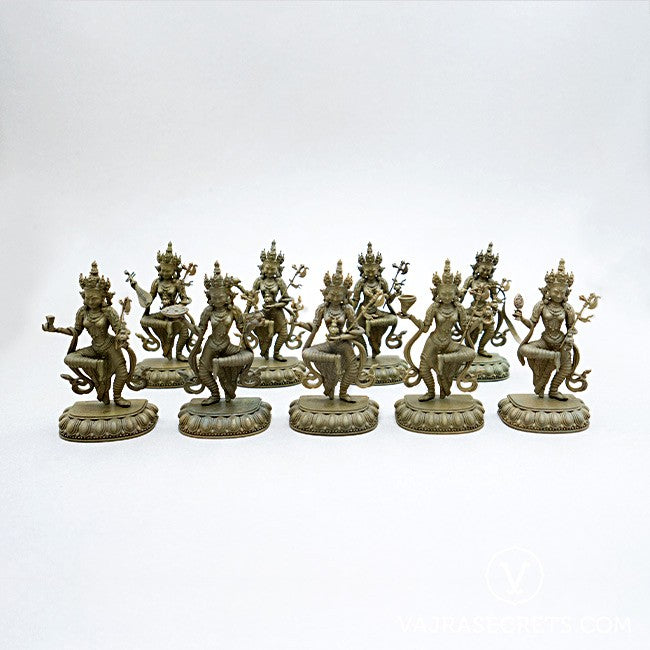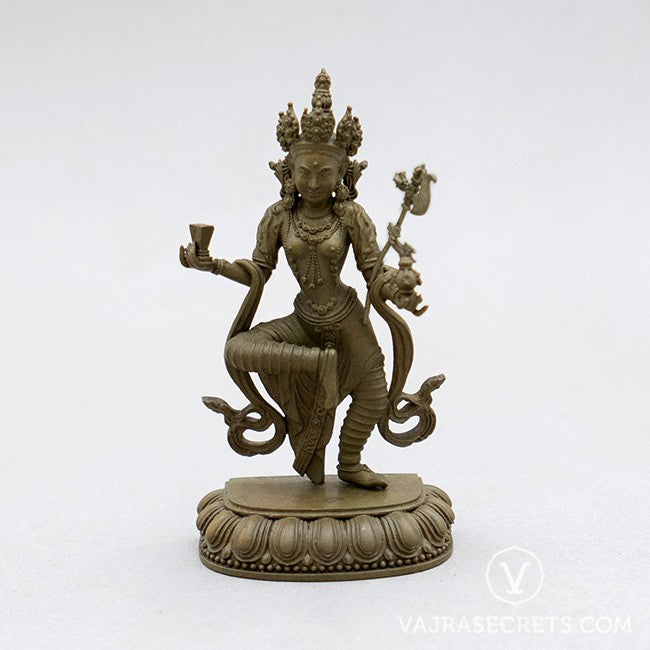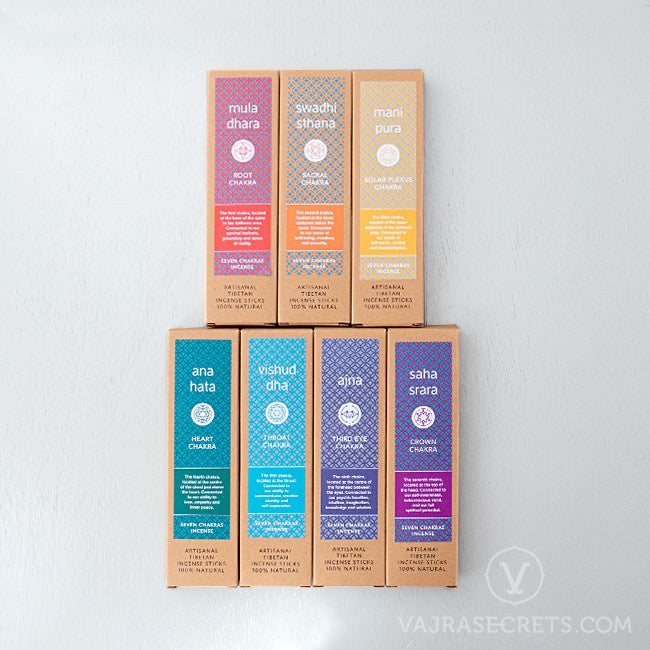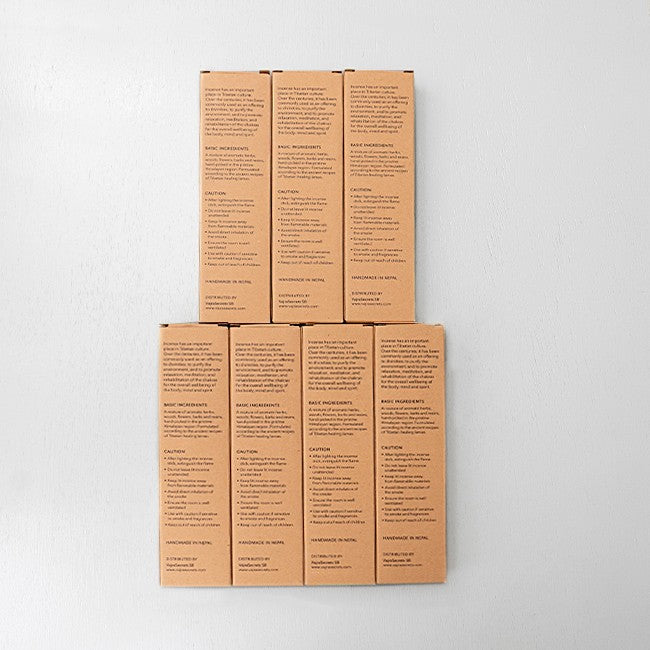About the Nine Great Mothers
The members of Dorje Shugden’s entourage – the Eight Guiding Monks, the Nine Great Mothers and the Ten Youthful and Wrathful Attendants – are manifestations of his mind. Taking on various appearances and forms, they each perform a specific function in relation to your spiritual path in general and your practice of Dorje Shugden in particular.
The Nine Great Mothers are divinely beautiful celestial maidens who help practitioners develop control over the body’s four elements and five senses. In particular, they aid Tantric practitioners to gain attainments through higher levels of meditations.
Our quality representations are made in strict accordance to the iconography taught by H.E. Kyabje Dagom Rinpoche.
The full set includes:
- White Goddess of Earth, representing Lochana
- Blue Goddess of Water, representing Mamaki
- Red Goddess of Fire, representing Pandaravasini
- Green Goddess of Wind, representing Tara
- White Goddess of Form, representing Rupavajra
- Yellow Goddess of Sound, representing Shaptavajra
- Red Goddess of Scent, representing Gandhavajra
- Green Goddess of Taste, representing Rasavajra
- Blue Goddess of Sensations, representing Parshavajra
1. White Goddess of Earth
The first of the Nine Great Mothers, the White Goddess of Earth represents the Goddess Lochana, the consort of Akshobhya. Adorned with precious ornaments and celestial silken garments, she is white in colour and manifests as a charming youth of unsurpassable beauty in a dancing posture. In her right hand, she carries Mount Meru and in her left she holds a treasure vase. She carries a golden vajra axe in the crook of her left arm and abides amidst a gathering of rainbows and clouds. In Dorje Shugden's mandala, she appears midway between Shize and Trakze.
2. Blue Goddess of Water
The second of the Nine Great Mothers, the Blue Goddess of Water represents the Goddess Mamaki, the consort of Ratnasambhava. Adorned with precious ornaments and celestial silken garments, she is light blue in colour and manifests as a charming youth of unsurpassable beauty in a dancing posture. In her right hand, she hold a precious vase overflowing with nectar and in her left she holds a treasure vase. She carries a golden vajra axe in the crook of her left arm and abides amidst a gathering of rainbows and clouds. In Dorje Shugden's mandala, she appears to the left of the Goddess of Earth.
3. Red Goddess of Fire
The third of the Nine Great Mothers, the Red Goddess of Fire represents the Goddess Pandaravasini, the consort of Amitabha. Adorned with precious ornaments and celestial silken garments, she is red in colour and manifests as a charming youth of unsurpassable beauty in a dancing posture. In her right hand, she holds aloft a burning flame with a wrathful mudra and in her left she holds a treasure vase. She carries a golden vajra axe in the crook of her left arm and abides amidst a gathering of rainbows and clouds. In Dorje Shugden's mandala, she appears to the left of the Goddess of Water.
4. Green Goddess of Wind
The fourth of the Nine Great Mothers, the Green Goddess of Wind represents the Goddess Tara, the consort of Amoghasiddhi. Adorned with precious ornaments and celestial silken garments, she is green in colour and manifests as a charming youth of unsurpassable beauty in a dancing posture. Her right hand is in a wrathful mudra, creating wind, and in her left she holds aloft a treasure vase. She carries a golden vajra axe in the crook of her left arm and abides amidst a gathering of rainbows and clouds. In Dorje Shugden's mandala, she appears to the left of the Goddess of Fire.
5. White Goddess of Form
The fifth of the Nine Great Mothers, the White Goddess of Form is also known as Rupavajra, the offering goddess representing the emptiness of visible objects. Adorned with precious ornaments and celestial silken garments, she is white in colour and manifests as a charming youth of unsurpassable beauty in a dancing posture. She holds a mirror in her right hand and a treasure vase in her left. She carries a golden vajra axe in the crook of her left arm and abides amidst a gathering of rainbows and clouds. In Dorje Shugden's mandala, she appears two levels below Shize.
6. Yellow Goddess of Sound
The sixth of the Nine Great Mothers, the Yellow Goddess of Sound is also known as Shaptavajra, the offering goddess representing the emptiness of sound. Adorned with precious ornaments and celestial silken garments, she is yellow in colour and manifests as a charming youth of unsurpassable beauty in a dancing posture. She holds a vina in her right hand and a treasure vase in her left. She carries a golden vajra axe in the crook of her left arm and abides amidst a gathering of rainbows and clouds. In Dorje Shugden's mandala, she appears slightly below and to the left of the Goddess of Form.
7. Red Goddess of Scent
The seventh of the Nine Great Mothers, the Red Goddess of Scent is also known as Gandhavajra, the offering goddess representing the emptiness of smell. Adorned with precious ornaments and celestial silken garments, she is red in colour and manifests as a charming youth of unsurpassable beauty in a dancing posture. She holds a conch shell filled with perfume in her right hand and a treasure vase in her left. She carries a golden vajra axe in the crook of her left arm and abides amidst a gathering of rainbows and clouds. In Dorje Shugden's mandala, she appears slightly below and to the left of the Goddess of Sound.
8. Green Goddess of Taste
The eighth of the Nine Great Mothers, the Green Goddess of Taste is also known as Rasavajra, the offering goddess representing the emptiness of taste. Adorned with precious ornaments and celestial silken garments, she is green in colour and manifests as a charming youth of unsurpassable beauty in a dancing posture. She holds a vessel filled with exquisite delicacies in her right hand and a treasure vase in her left. She carries a golden vajra axe in the crook of her left arm and abides amidst a gathering of rainbows and clouds. In Dorje Shugden's mandala, she appears slightly above and to the left of the Goddess of Scent.
9. Blue Goddess of Sensations
The last of the Nine Great Mothers, the Blue Goddess of Sensations is also known as Parshavajra, the offering goddess representing the emptiness of tangible objects. Adorned with precious ornaments and celestial silken garments, she is blue in colour and manifests as a charming youth of unsurpassable beauty in a dancing posture. She holds a delicate blue garment in her right hand and a treasure vase in her left. She carries a golden vajra axe in the crook of her left arm and abides amidst a gathering of rainbows and clouds. In Dorje Shugden's mandala, she appears slightly above and to the left of the Goddess of Taste.



































